10 Years 10 Films (10Y10F) is a project to display embedded YouTube selections of cinema history. This is Part IV of a series that gives the viewer a quick time-lapse view of how movie technology and style has developed throughout the world – one clip each year – from 1888 through 2017, starting with the foundations to see how filmmakers build or deconstruct them.

As “the war to end all wars” came to a close in 1918, the destruction in Europe shifted the center of the film world to Hollywood. By 1928, the “Big Five” studios had been established and they dominated the artistic and economic production of films in the United States.[1] This was particularly stifling for women directors as alpha males created a toxic environment on set.[2]
Despite – or perhaps because of – their lack of resources, German filmmakers in particular were especially creative during this time. Foreign language films were rarely exhibited in the States, but as the political situation worsened, several directors from Europe and Russia were recruited to Hollywood.
This is an era that continues to be revered today, with frequent exhibitions of classics like Metropolis, Within Our Gates, The Adventures of Prince Achmed, The Gold Rush, Battleship Potemkin, Nosferatu, and The Mark of Zorro to name a few.
In Part V, we’ll explore the impact of the Hays Code developed throughout the Twenties and early Thirties. The film industry as “big business” forced moviemakers to devise a system of self-regulation. Prohibition (1920-1933) spawned a new genre of gangster films, and various other moral issues needed to be addressed to avoid government regulation. And, of course, “talkies” took over the industry. Stay tuned!
Click on the Expand arrow for more details and additional films of note for that year. Disclaimers, an embedded YouTube playlist of the 10 films highlighted here, and links to helpful websites are at the end of this post.*
10Y10F Series:
I 1888-1897, II 1898-1907,
III 1908-1917, IV 1918-1927,
V 1928-1937, VI 1938-1947,
VII 1948-1957 …
/ Collapse All ˄
1918 – I Don’t Want to Be a Man (Lubitsch; Germany)
Comedy about a young woman (Ossi Oswalda) who goes out on the town dressed as a man. One reviewer on IMDb put it succinctly: “Homoeroticism, transvestitism, gender confusion, dominance and submission, borderline pedophilia — there has never been another, and certainly will never be another like Ernst Lubitsch.” This is an early film from Lubitsch, a German-born director who moved to Hollywood in 1922. He was well-respected throughout his career and continued working all the way up until his death in 1947. Expand
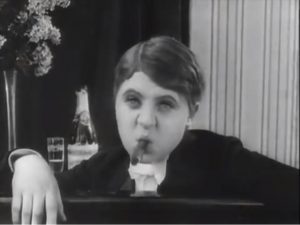 Ich möchte kein Mann sein. 45min. Germany.
Ich möchte kein Mann sein. 45min. Germany.
Other film(s): A Trip to Mars (Himmelskibet, literally “Sky Ship.” 80min. Holger-Madsen. Denmark.) A group of researchers from Earth travel in a spaceship to Mars, where, to big surprise, they find a peaceful vegetarian and pacifist civilization. A Scandinavian space opera!
World events in 1918: The Spanish flu pandemic kills over 50 million people worldwide. The Russian Civil War begins, with Lenin’s Red Army vs. the anti-Communist White Army. T. E. Lawrence “of Arabia” concludes his affairs in the Middle East as World War I ends in November. Births: American filmmaker Ida Lupino, Swedish filmmaker Ingmar Bergman, German Shepherd canine actor Rin Tin Tin (rescued from a WWI battlefield).
1919 – Feline Follies (Messmer; USA)
Felix the Cat was the first mass-marketed, animated character. In this, his first short, he is called Master Tom and is distracted by Miss Kitty when he is supposed to be protecting the house from mice. Wait for the morbid ending! Expand
 4min. Otto Messmer, from New Jersey, worked in Pat Sullivan’s New York City studio. The Felix cartoons are credited to the Australian-born Sullivan, but it’s widely believed that Messmer was the primary creator of the cartoon.
4min. Otto Messmer, from New Jersey, worked in Pat Sullivan’s New York City studio. The Felix cartoons are credited to the Australian-born Sullivan, but it’s widely believed that Messmer was the primary creator of the cartoon.
Other film(s): The Tantalizing Fly (“Out of the Inkwell” series. 4min. USA.) This is the first major success of animator Max Fleischer who later went on to popularize Bettie Boop, Popeye, and one of my personal favorite childhood films, Gulliver’s Travels.
The Grey Automobile (El automóvil gris. 105min. Enrique Rosas. Mexico City.) A police inspector fights vandalism. An early Mexican blockbuster based on actual events.
World events in 1919: Film stars Charlie Chaplin, Mary Pickford, Douglas Fairbanks and director D. W. Griffith launch United Artists, a New York City production company. Relating to the end of World War I, the Faisal–Weizmann Agreement and Treaty of Versailles are signed. Births: American actress Jennifer Jones, English actress Patricia Laffan, American jazz musician Nat King Cole.
1920 – Within Our Gates (Micheaux; USA)
Abandoned by her fiancé, an educated woman with a shocking past dedicates herself to helping a near-bankrupt school for impoverished youths. This is the earliest surviving feature film produced by African Americans. Expand
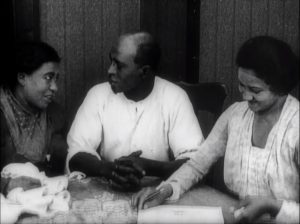 80min. Oscar Micheaux. Chicago, IL. Note: Check out the Kino Pioneers of African-American Cinema set, also streaming on Kanopy.
80min. Oscar Micheaux. Chicago, IL. Note: Check out the Kino Pioneers of African-American Cinema set, also streaming on Kanopy.
Other film(s): The Cabinet of Dr. Caligari (75min. Robert Wiene. Germany.) A demented hypnotist uses a sleepwalker to perform a series of murders. One of the most popular silent films of all time, Caligari is an early example of Expressionism in film.
The Daughter of Dawn (76min. Norbert A. Myles. Oklahoma, USA.) A love triangle, reportedly based on an old Comanche legend. Produced by the Texas Film Company, the film’s entire cast was comprised of Native Americans, mostly Kiowa and Comanche. More details about the film and its 2012 restoration from the Oklahoma Historical Society.
Bonus: Early clips of Babe Ruth playing baseball, likely from 1920 Pathé News. Good quality, 1080p. 11min.
World events in 1920: The Eighteenth and Nineteenth Amendments to the US Constitution prohibit alcohol and guarantee women’s suffrage. The Summer Olympics in Belgium debuts the flag of five interlocking circles. The Nazi Party is formed in Germany, led by Anton Drexler and Adolf Hitler. Births: Italian director Federico Fellini, American actors Walter Matthau and Maureen O’Hara, Japanese actor Toshiro Mifune.
1921 – The Phantom Carriage (Sjöström; Sweden)
https://youtu.be/hzOk7hkDUew
On New Year’s Eve, the driver of a ghostly carriage forces a drunken man to reflect on his selfish, wasted life. This is the second Victor Sjöström film featured in the 10Y10F series, but certainly his most well known and influential – particularly due to the double-exposure film work and emotional impact. Expand
 Körkarlen aka The Stroke of Midnight (1922 US title). 106min. Stockholm, Sweden.
Körkarlen aka The Stroke of Midnight (1922 US title). 106min. Stockholm, Sweden.
Other film(s): The Four Horsemen of the Apocalypse (132min. Rex Ingram. USA.) An extended family split up in France and Germany find themselves on opposing sides of the battlefield during World War I. Written by film executive June Mathis, who casted Rudolph Valentino – instantly making him a star as the “Latin lover” and tango dancer. It has been estimated that Four Horsemen was the 4th most successful silent film out of Hollywood.
World events in 1921: Albert Einstein is awarded the Nobel Prize in Physics. The radio is popularized as the first commercial broadcast entertainment technology. Births: Indian Bengali filmmaker Satyajit Ray, American actors Charles Bronson, Donna Reed, Rodney Dangerfield, and Lana Turner.
1922 – Nanook of the North (Flaherty; USA)
This early full-length documentary looks at the life of Nanook “The Bear,” an Inuit living on the shores of Hudson’s Bay in Northern Quebec. Expand
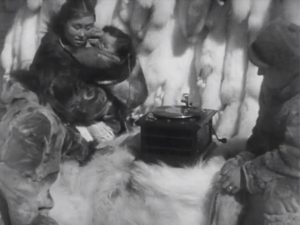 78min. Robert J. Flaherty. Filmed in Canada.
78min. Robert J. Flaherty. Filmed in Canada.
Other film(s): Nosferatu: A Symphony of Horror (93min.) Vampire Count Orlok expresses interest in a new residence and real estate agent Hutter’s wife. Yet another German auteur, F.W. Murnau, directed this haunting film. It became one of the first “cult classics” after the Stoker family won a copyright infringement case and ordered all copies of the film to be destroyed. Check out Murnau’s 1927 film Sunrise for another one of his must-see classics.
Laboror’s Love (aka Romance of a Fruit Peddler. 22min. Zhang Shichuan. Shanghai, China.) This oldest extant Chinese film is a synthesis of Harold Lloyd-like silent comedy and the May 4th literature then in fashion. While the film’s charming story of a soft-hearted carpenter turned fruit peddler trying to impress his future father-in-law does not much seem like a call to class warfare, the pointed references to urban corruption and the character of a happily liberated young woman anticipate the progressive impulse in much Chinese cinema to come.
World events in 1922: Mahatma Gandhi is sentenced to six years in prison for sedition (serving out two). The National Fascist Party and Benito Mussolini take power in Italy. Joseph Stalin is appointed General Secretary of the Soviet Communist Party. The Ottoman Empire is abolished after 600 years. Births: American actors Betty White, Bea Arthur, Judy Garland, Dorothy Dandridge, Stan Lee, and Red Foxx. French director Alain Resnais. Still-active Bulgarian actress Stoyanka Mutafova.
1923 – The Smiling Madame Beudet (Dulac; France)
The sarcastically-titled tale of a repressed married woman and a practical joke involving a pistol. This is regarded as one of the first feminist films and part of the French impressionist movement. Expand
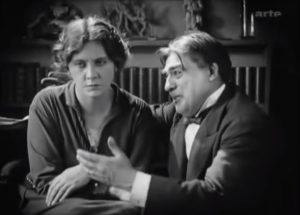 La souriante Madame Beudet. 38min. Germaine Dulac.
La souriante Madame Beudet. 38min. Germaine Dulac.
Other film(s): Safety Last! (73min. Hollywood, USA.) A store clerk organizes a publicity stunt in which a friend climbs the outside of a tall building. The image of the famously-spectacled Harold Lloyd hanging from a clock is one of the most iconic images from silent slapstick comedy.
World events in 1923: The HOLLYWOODLAND letters are built on Mount Lee, later shortened to HOLLYWOOD. The Republic of Turkey is formed after the fall of the Ottoman Empire. Births: American actors Charleton Heston and Jean Stapleton, English filmmaker Sir Richard Attenborough, and Indian filmmaker Dev Anand.
1924 – Sherlock Jr. (Keaton; USA)
The floor sweeper and projectionist of a small-town movie theater studies to be a detective in his free time. Buster Keaton is often compared to Charlie Chaplin. Both directed, acted in, produced, and wrote many hugely popular slapstick comedies in the 1920s, but Keaton was also an incomparable stunt performer. Expand
 44min. Hollywood. Check out Silent Witness – the House that Watched Over Chaplin and Keaton by John Bengtson, 9/20/16. His website Chaplin-Keaton-Lloyd film locations (and more) is a fascinating resource.
44min. Hollywood. Check out Silent Witness – the House that Watched Over Chaplin and Keaton by John Bengtson, 9/20/16. His website Chaplin-Keaton-Lloyd film locations (and more) is a fascinating resource.
Other film(s): The Epic of Everest [trailer] (87min. John Baptist Lucius Noel. England.) While the term “documentary” still did not exist in 1924, the desire to document expeditions to the poles and coldest environments of the Earth was strong in the 1920s! I’ve written a full review on Letterboxd, highlighting the 2014 BFI Blu-ray.
The Saga of Gösta Berling (183min. Sweden.) Based on a novel, described as a “prose epic of Swedish country life.” Mauritz Stiller was an openly gay, popular Nordic film-maker. He “discovered” Greta Garbo and cast her in this, her first film role. It was released theatrically in two parts, but some of it remains lost after being recut over the years.
World events in 1924: The UK recognizes the USSR and the Soviet Constitution is ratified. The Immigration Act is signed in the US, excluding Asians from immigrating and expanding deportation policies. Edwin Hubble announces that Andromeda is a galaxy, much like our Milky Way. Births: American director Sidney Lumet, actor Marlon Brando, actresses Eva Marie Saint and Cicely Tyson, and Indian filmmaker Raj Kapoor.
1925 – Gold Rush (Chaplin; USA)
A prospector goes to the Klondike in search of gold and finds it and more. The crowning achievement of Charlie Chaplin’s silent film career, as he himself claimed. Expand
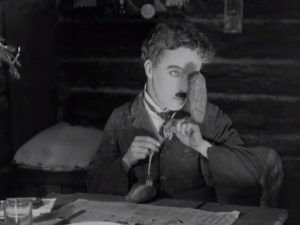 87min, original 1925 release arguably in public domain; new score. (1942 re-release was cut with sound, 72min.) Hollywood & Sierra Nevada area, California.
87min, original 1925 release arguably in public domain; new score. (1942 re-release was cut with sound, 72min.) Hollywood & Sierra Nevada area, California.
Other film(s): Battleship Potemkin (Bronenosets Potyomkin. 71min. Sergei Eisenstein. Odessa, USSR.) A dramatized account of a great Russian naval mutiny and a resultant public demonstration, which brought on a police massacre. The film often tops out as the best silent film of all time and is a masterful example of montage editing and propaganda.
The Light of Asia (Prem Sanyas. 95min. Franz Osten, Himansu Rai. India.) Based on an English book of verse about the life of Buddha. Directors Osten (German) and Rai (Indian) teamed up on a number of films over the years and later made the Bombay Talkies a well-respected studio.
The Red Kimono [clip] (78min. Walter Lang, Dorothy Davenport uncredited. Hollywood, USA.) Davenport produced and narrated (as Mrs. Wallace Reid) this film about white slavery, based on a true case of prostitution in New Orleans. Oddly, the title credit in the film itself is misspelled as “Kimona”! Otherwise, this was one of the most interesting films I ran across for this decade of 10Y10F – the production is engaging throughout.
The Phantom of the Opera (105min. Rupert Julian, born in New Zealand. Filmed in Hollywood.) Based on the popular novel, this film is most famous for Lon Chaney’s ghastly, self-devised make-up, which was kept a studio secret until the film’s premiere. Segments of the film were shot and tinted using the most advanced color-in-film technology for the time.
World events in 1925: Scopes Trial on evolution in Tennessee. The Great Gatsby and Hitler’s Mein Kampf published. Margaret Mead lands in American Samoa for anthropological field work. Births: American actors Jack Lemmon, Elaine Stritch, Sammy Davis Jr., Paul Newman, and Dick Van Dyke. Chinese actress and scriptwriter Huang Zongying. British actors Dame Angela Lansbury and Peter Sellers.
1926 – A Page of Madness (Kinugasa; Japan)
A man takes a job at an asylum with hopes of freeing his imprisoned wife. This film is a highly-experimental work of art. It is considered a horror film and takes the viewpoint of the mentally ill. Kinugasa continued to make well-known films into the 1960s. Expand
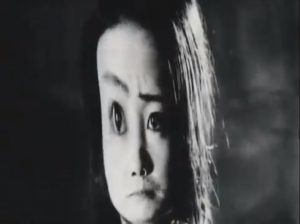 Kurutta Ichipeiji. 71min [incomplete]. Teinosuke Kinugasa.
Kurutta Ichipeiji. 71min [incomplete]. Teinosuke Kinugasa.
Other film(s): The Adventures of Prince Achmed [trailer] (66min. Lotte Reiniger. Germany.) A prince rides a flying horse on magical adventures, which include befriending a witch, meeting Aladdin, battling demons and falling in love with a princess. A stunningly-original animation technique using paper cutouts on colored backgrounds. This is also the first feature-length animated film.
Don Juan [clip] (112min. Alan Crosland. Hollywood, USA.) Based on Lord Byron’s epic poem. A typical blockbuster for the time, chosen for 10Y10F to highlight John Barrymore (part of the famous acting family). Two minutes into the YouTube clip here, you can hear the swords clicking as this was the first feature-length Vitaphone sync-sound film.[3] This clip of Will Hays (of the infamous Hollywood Production Code) was played in theaters to introduce the film.
The Black Pirate (95min. Albert Parker. Hollywood, USA.) Seeking revenge, an athletic young man joins the pirate band responsible for his father’s death. One of Douglas Fairbanks’ many swashbuckling adventure films. This one is the first filmed entirely in two-color Technicolor and famous for the scene where he descends a ship sail with a knife (31m31s mark).
World events in 1926: “Talkie” Movietone and Vitaphone patents steer the industry toward a 24 frame per second standard (or 90 feet per minute as it was measured at the time). Most silent films had no standard speed, and directors even requested that different reels of the same film be played at different speeds by projectionists. Winnie-the-Pooh is published. Births: South Korean filmmaker Shin Sang-ok, Canadian-American actor Leslie Nielsen, and Americans Mel Brooks, Andy Griffith & Marilyn Monroe (these two born on the same day).
1927 – Metropolis (Lang; Germany)
Set in the year 2026, a city is split into an upper class and an underground (literally) class. The son of the city’s mastermind gets caught up in an uprising involving a woman he loves and a robot controlling the masses. Mittler zwischen Hirn und Händen muss das Herz sein (“THE MEDIATOR BETWEEN BRAIN AND HANDS MUST BE THE HEART!”)
Metropolis is the undisputed pinnacle of silent film-making, at least in the “science fiction” genre. Director Fritz Lang produced many epic films in the 1920s, but this was his most ambitious – overly so. It cost over 5 million Reichmarks and made less than 100 thousand. It premiered in January at around 2 ½ hours in length, but was so controversial that within months, around 30 minutes were cut for various political reasons. The full length film was considered “lost” until 2008 and had its second “premiere” after an unprecedented restoration, in 2010. Expand
 147min. Fritz Lang. I chose the version posted above as it includes the original 1927 score by Gottfried Huppertz, reworked and recorded by conductor Frank Strobel; this is the Kino version with English intertitles. I would also recommend this playlist of the entire film, rescored by The New Pollutants and first performed in 2005, then reworked for the 2010 restoration; intertitles in English.
147min. Fritz Lang. I chose the version posted above as it includes the original 1927 score by Gottfried Huppertz, reworked and recorded by conductor Frank Strobel; this is the Kino version with English intertitles. I would also recommend this playlist of the entire film, rescored by The New Pollutants and first performed in 2005, then reworked for the 2010 restoration; intertitles in English.
Other film(s): Hyas and Stenorrynchus [clip] (9min. France. Sound added in 1929?) I was so surprised and impressed when I ran across Jean Painlevé’s nature films that I wrote a whole post about it.
Women of Ryazan (Baby ryazanskie, aka The Peasant Women of Riazan. 88min. Olga Preobrazhenskaya and Ivan Pravov. USSR.) A study of two young women living in rural Russia and how they deal with life, love and the First World War. A quick shout-out to Fritzi Kramer of Movies Silently; she reviews silent films with lots of screenshots, detailed plot summaries, and often embedded GIFs. After doing 10Y10F research for a couple of years now, I’ve noticed that her reviews are always top notch, and she started a podcast in 2019, as well. Here’s her Women of Ryazan review.
World events in 1927: The Academy of Motion Picture Arts and Sciences (AMPAS, known later for the Academy Awards) elects Douglas Fairbanks, Sr., as its first president. Charles Lindbergh makes the first solo trans-Atlantic flight. World population reaches 2 billion. Births: French actress Emmanuelle Riva, English actor Roger Moore, American director Bob Fosse, actors Eartha Kitt, Sidney Poitier, and Harry Belafonte.
* DISCLAIMERS
As of 2019, American films made after 1923 are not in the public domain, so for the rest of the 10Y10F Series, full-versions of films will be harder to come by on YouTube.
On a personal note, I think it’s worth mentioning that there is a difference between “best” and “first” movies. It has never been my intention for this series to highlight the “best” films. 10Y10F is about movie technology, style, and other developments in the medium. But in thinking about “firsts,” I’ve decided to be more critical when looking at landmark films. The Jazz Singer (1927), for example, is lauded as the first feature length film with synchronized speech. However, to watch this film for any other reason these days is arguably a waste of time – dare I say it did not age well!
Also note: “Silent” films were usually accompanied by live music, narration, and/or sound effects – improvised, compiled from cue sheets of common themes, or more commonly in the 1920s original score. It’s hard to tell if the sound accompanying some of the clips in this post were intended by the original director. Precise details on the films are hard to come by, even in the history books, much less the repeated misinformation on the internet.
Other than a couple of classes in college involving film, I fully admit to having no professional training in cinema history. Please let me know if any corrections need to be made, or if you have any other feedback. I usually respond pretty quickly to comments on this site.
YouTube playlist: 10Y10F Part 4: 1918-1927
Endnotes
1 For more about studio development and movie stars of the era, I recommend AMC’s “The History of Film” website, by Tim Dirks.[Archived]
2 The best sources I’ve found about women in the film industry:
What Women In Film Can Learn From The “Manless Eden” That Was Hollywood’s Silent Era by Elena Nicolaou, 4/23/18.[Archived]
The Seventh Art – Pioneer Female Auteurs of Hindi Films and Hollywood (1920s-1950s) by Matma Joshi, 3/8/18.[Archived]
Three documentaries from 2018 (currently available streaming on Kanopy.com): Half the Picture, This Changes Everything, and Be Natural: The Untold Story of Alice Guy-Blaché.
3 Vitaphone, (Sound on disc) vs Photophone, Phonofilm & Movietone (Sound on film) by Bethany Jacobson, 5/17/14.[Archived]
10Y10F Series:
I 1888-1897, II 1898-1907,
III 1908-1917, IV 1918-1927,
V 1928-1937, VI 1938-1947,
VII 1948-1957 …
Comments
5 responses to “Video clips and history of world cinema: 1918-1927”
[…] Series: I 1888-1897, II 1898-1907, III 1908-1917, IV 1918-1927, V […]
[…] Series: I 1888-1897, II 1898-1907, III 1908-1917, IV 1918-1927, V […]
[…] Series: I 1888-1897, II 1898-1907, III 1908-1917, IV 1918-1927, V […]
[…] Series: I 1888-1897, II 1898-1907, III 1908-1917, IV 1918-1927, V 1928-1937 […]
[…] Series: I 1888-1897, II 1898-1907, III 1908-1917, IV 1918-1927, V 1928-1937, VI 1938-1947 […]